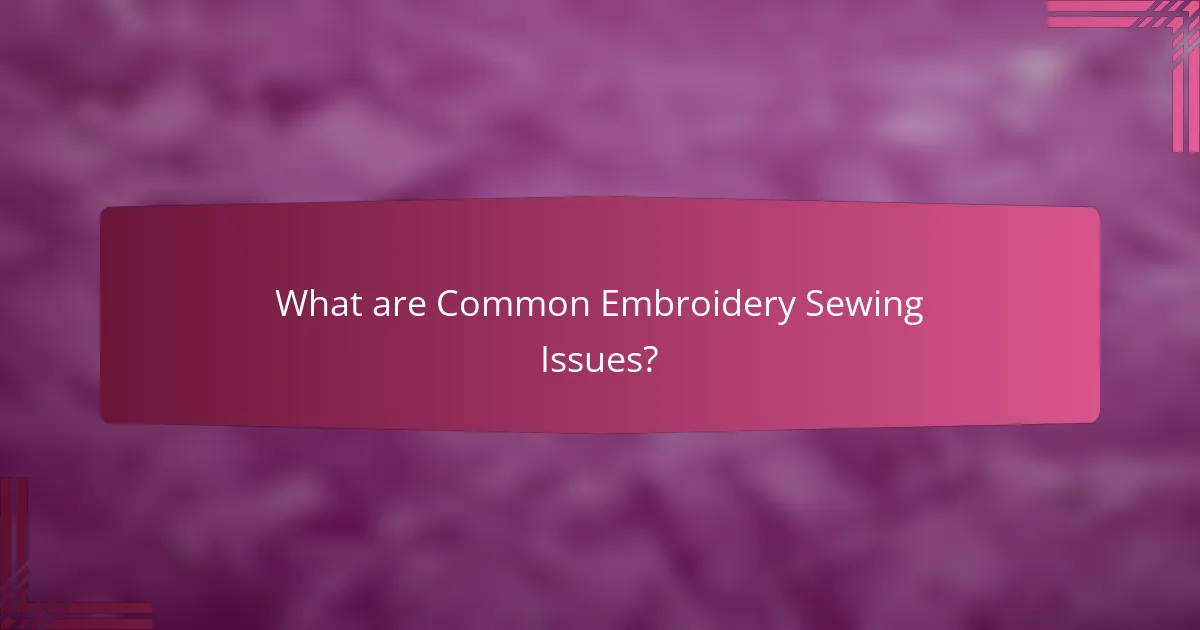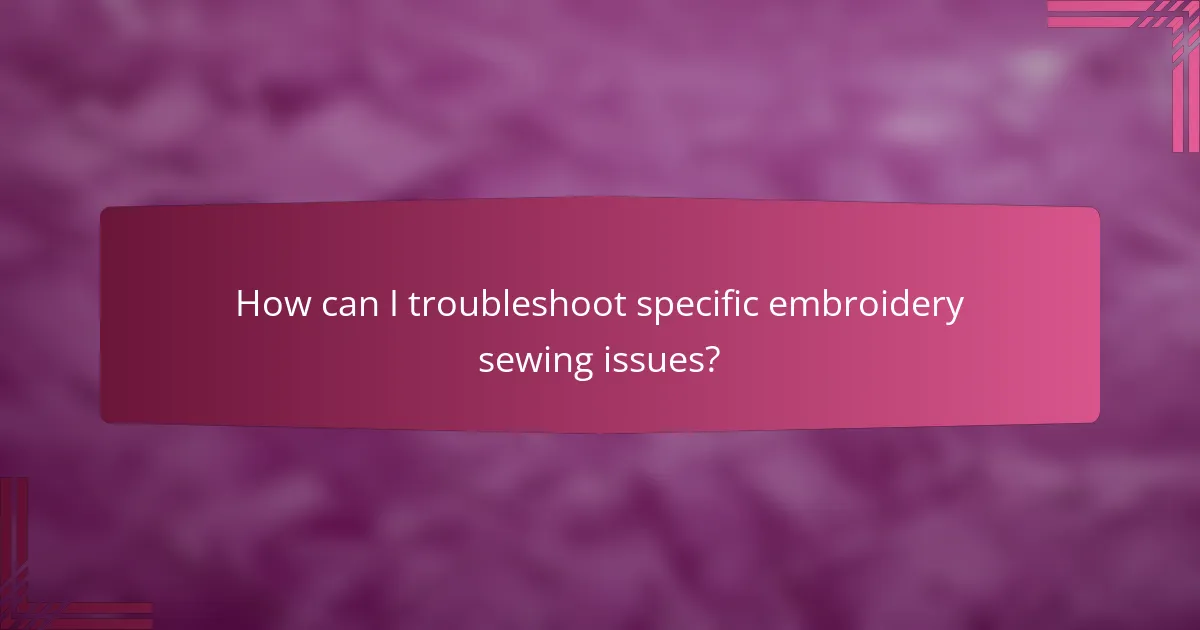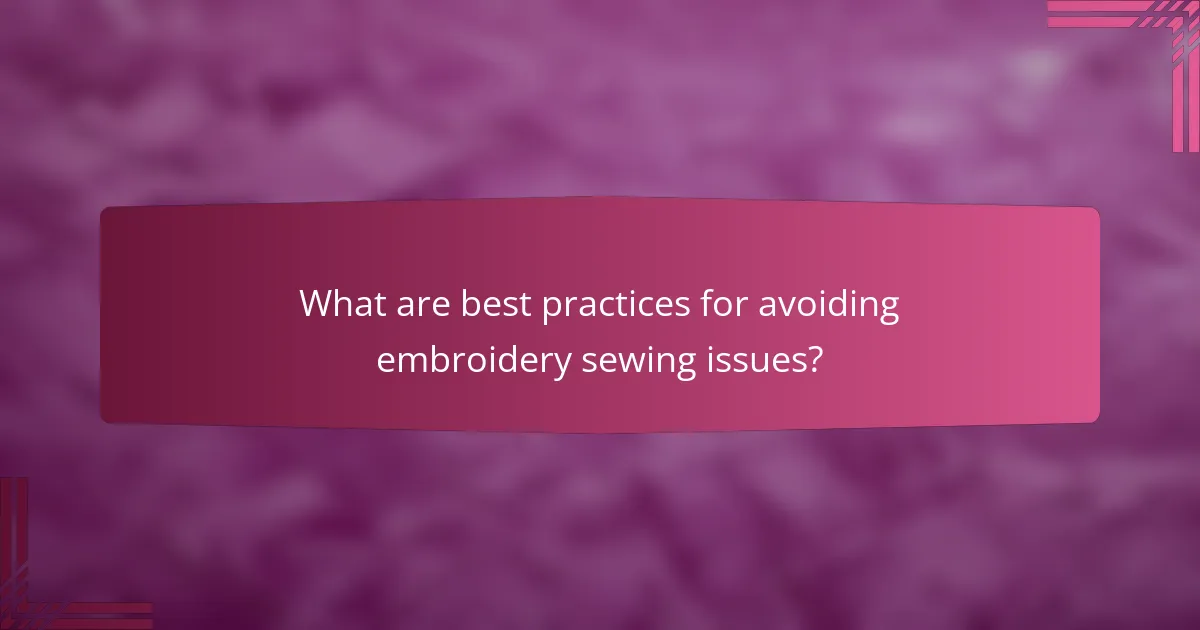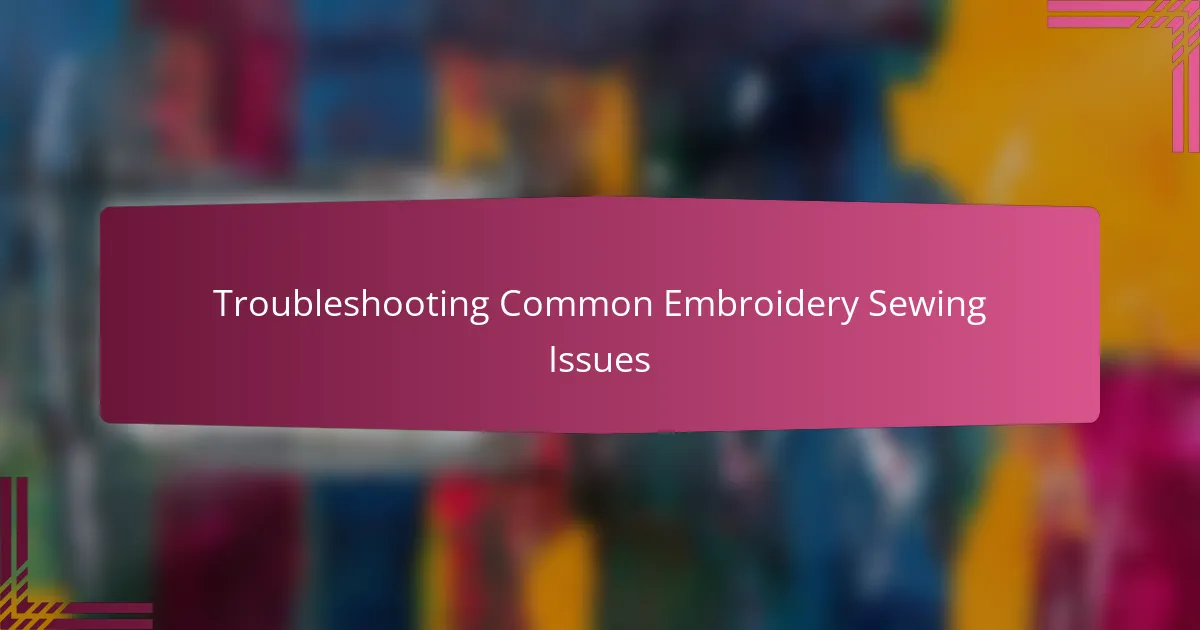
What are Common Embroidery Sewing Issues?
Common embroidery sewing issues include thread breakage, fabric puckering, and needle damage. Thread breakage often occurs due to improper tension or using the wrong needle type. Puckering happens when the fabric is not stabilized correctly or the tension is too tight. Needle damage can result from using a dull or incorrect needle for the fabric type. Other issues include skipped stitches, which are caused by a dirty machine or incorrect needle positioning. Additionally, thread nesting can occur due to incorrect threading or tension settings. Each of these problems can significantly affect the quality of the embroidery.
How can identifying these issues improve my embroidery projects?
Identifying issues in embroidery projects can significantly enhance the quality and efficiency of your work. By recognizing problems such as thread tension, needle type, and fabric compatibility, you can make informed adjustments. For example, correcting thread tension can prevent puckering and ensure smooth stitching. Using the appropriate needle type for your fabric can reduce skipped stitches and improve overall appearance. Additionally, addressing issues early can save time and resources, minimizing wasted materials. Understanding common embroidery challenges leads to more consistent results and greater satisfaction with finished projects.
What are the most frequently encountered problems in embroidery sewing?
Common problems in embroidery sewing include thread breakage, needle issues, and fabric puckering. Thread breakage often occurs due to incorrect tension or using the wrong type of thread. Needle issues can arise from using a dull needle or one that is not suitable for the fabric. Fabric puckering happens when the fabric is not properly stabilized or the tension is too tight. Other frequent problems include skipped stitches and poor design placement. Skipped stitches can result from a dirty machine or incorrect needle size. Poor design placement may lead to misalignment, affecting the overall quality of the embroidery. Addressing these issues can significantly improve the embroidery process.
How do these issues impact the quality of the finished product?
Issues in embroidery sewing significantly degrade the quality of the finished product. Problems such as thread tension, needle type, and fabric compatibility can lead to uneven stitching. Incorrect thread tension often results in puckering or loose stitches. Using the wrong needle type can cause skipped stitches or fabric damage. Additionally, incompatible fabrics may lead to fraying or distortion of the design. Each of these issues directly affects the aesthetic and functional aspects of the final embroidery. For instance, studies show that proper tension settings can improve stitch quality by up to 50%. Therefore, addressing these issues is crucial for achieving high-quality embroidery results.
What are the root causes of embroidery sewing issues?
Root causes of embroidery sewing issues include improper thread tension, needle problems, and fabric choice. Incorrect thread tension can lead to puckering or looping of stitches. Using the wrong needle type can cause skipped stitches or fabric damage. Incompatible fabric can result in poor stitch quality or distortion. Additionally, insufficient stabilization may lead to fabric movement during embroidery. Lastly, machine maintenance issues can contribute to overall sewing problems. Each of these factors directly impacts the quality and accuracy of the embroidery process.
How do thread tension and type affect embroidery outcomes?
Thread tension and type significantly influence embroidery outcomes. Proper thread tension ensures that the stitches are neither too tight nor too loose. Tight tension can cause puckering, while loose tension can lead to looping and uneven stitches.
The type of thread impacts the overall appearance and durability of the embroidery. For instance, polyester threads are strong and colorfast, making them ideal for machine embroidery. Cotton threads, while softer, may not hold up as well under stress.
Using the correct thread type for the fabric is essential. For example, using a heavier thread on lightweight fabric can create distortion. Conversely, a lightweight thread on heavy fabric may not provide adequate coverage.
Adjusting thread tension based on the thread type can enhance stitch quality. For example, a thicker thread may require looser tension to prevent breakage.
In summary, both thread tension and type are critical for achieving high-quality embroidery results.
What role does fabric choice play in common embroidery problems?
Fabric choice significantly impacts common embroidery problems. Different fabrics have varying levels of stability, texture, and thickness. For instance, stretchy fabrics can lead to distortion during the embroidery process. This distortion may result in uneven stitches or puckering. Conversely, tightly woven fabrics provide a stable base, reducing the likelihood of such issues. Fabrics with a high nap, like fleece, can cause thread tension problems. This can lead to thread breaks or skipped stitches. Additionally, the weight of the fabric affects needle choice and thread tension settings. Using the wrong needle type for a specific fabric can exacerbate embroidery issues. Therefore, selecting the appropriate fabric is crucial for successful embroidery outcomes.
What are the solutions for fixing common embroidery sewing issues?
Common embroidery sewing issues can be resolved with specific solutions. For thread breaking, ensure the correct thread type and tension settings are used. Adjust the upper tension if the thread is too tight. If fabric puckering occurs, use a stabilizer to support the fabric during stitching. For skipped stitches, check the needle for damage and replace it if necessary. Ensure the needle is suitable for the thread and fabric type. If the design is not stitching correctly, verify the design file for errors. Clean the machine regularly to prevent lint buildup, which can cause various issues. Lastly, always refer to the sewing machine manual for specific troubleshooting tips related to your model.
How can I adjust thread tension to resolve stitching problems?
To adjust thread tension and resolve stitching problems, locate the tension adjustment dial on your sewing machine. Turn the dial to increase tension if the stitches are loose. Conversely, decrease tension if the stitches are too tight. Test the adjustment by sewing a sample piece of fabric. Observe the stitch quality to ensure it is even and balanced. Proper tension ensures that the upper and lower threads meet correctly. Incorrect tension can lead to issues like puckering or thread breakage. Regularly check and adjust tension for optimal sewing performance.
What techniques can I use to prevent fabric puckering during embroidery?
To prevent fabric puckering during embroidery, use stabilizers, adjust tension, and select appropriate needle types. Stabilizers provide support to the fabric, reducing movement. Choose tear-away, cut-away, or water-soluble stabilizers based on the fabric type. Adjusting the machine tension ensures even thread distribution. Too tight tension can cause puckering, while too loose can lead to uneven stitches. Selecting the right needle type for the fabric is crucial. For lightweight fabrics, use a fine needle. For heavier materials, a larger needle is advisable. Proper hooping technique is also essential. Ensure the fabric is taut in the hoop without being stretched. Following these techniques significantly minimizes the risk of puckering.

How can I troubleshoot specific embroidery sewing issues?
To troubleshoot specific embroidery sewing issues, first identify the problem. Common issues include thread breakage, uneven stitches, and fabric puckering. For thread breakage, check the thread tension and ensure the needle is appropriate for the fabric type. Uneven stitches may indicate incorrect hooping or a dull needle. To resolve fabric puckering, use stabilizers and adjust the tension settings. Each of these solutions addresses the root cause of the specific issue. Proper maintenance of the sewing machine also contributes to minimizing these problems. Regular cleaning and oiling can enhance performance and reduce complications.
What steps should I take when I encounter thread breakage?
When you encounter thread breakage, first check the thread tension. Incorrect tension can cause the thread to snap. Next, inspect the needle for damage or dullness. A worn needle can lead to breakage. Ensure you are using the correct needle type for your fabric. Also, verify that the thread is properly threaded through the machine. Misthreading can create excess friction. Examine the thread for knots or tangles. These obstructions can cause breaks during sewing. Finally, ensure the bobbin is correctly wound and inserted. An improperly wound bobbin can lead to thread issues.
What adjustments can I make to my machine to prevent thread breakage?
Adjust the tension settings on your machine to prevent thread breakage. Proper tension ensures the thread flows smoothly without excessive strain. Check the upper thread tension first. It should be set according to the type of thread you are using. For most embroidery threads, a tension of 4 to 6 is recommended.
Next, examine the bobbin tension. It should also be adjusted to match the upper tension. A loose bobbin can cause uneven stitches and breakage. Ensure the thread is wound evenly on the bobbin. Uneven winding can lead to thread snagging.
Additionally, use the correct needle size for your thread and fabric. A needle that is too small can cause the thread to break. Regularly clean the machine to remove lint and debris. This maintenance helps keep the thread path clear.
Finally, ensure that the thread is properly threaded through the machine. Incorrect threading can lead to tension issues and breakage. Adjusting these elements can significantly reduce the likelihood of thread breakage during embroidery.
How can I select the right thread for my embroidery project?
To select the right thread for your embroidery project, consider the type of fabric you are using. Different fabrics require specific thread types for optimal results. For example, cotton thread works well on cotton fabrics, while polyester thread is better for synthetic materials.
Next, choose the appropriate thread weight. Thicker threads are suitable for bold designs, while finer threads work best for detailed work. Standard embroidery thread weights include 40wt for most projects and 30wt for larger, bolder designs.
Additionally, consider the thread finish. A shiny finish can enhance the look of your embroidery, while a matte finish offers a more subtle appearance.
Finally, ensure that the thread color complements your fabric and design. Selecting contrasting colors can make your embroidery stand out, while similar shades can create a more blended look.
What should I do if my embroidery design is not stitching correctly?
Check the thread tension first. Incorrect tension can cause poor stitching. Ensure the upper and bobbin threads are properly threaded. Misalignment can lead to stitching issues. Inspect the needle for damage or size. A bent or dull needle affects performance. Verify that the design settings match the fabric type. Mismatched settings can cause errors. Clean the machine to remove lint and debris. Blockages can disrupt the stitching process. Test the design on a scrap piece before finalizing. This helps identify issues early on.
How can I ensure proper alignment and placement of my design?
To ensure proper alignment and placement of your design, use a marking tool for precise positioning. Marking tools help indicate where the design should be placed on the fabric. Additionally, utilize a hoop that fits the design size correctly. A well-fitted hoop prevents fabric shifting during stitching.
Align the fabric edges with the hoop’s edges for consistent placement. This alignment ensures the design appears centered and straight. Use templates or guides for larger designs to aid in accurate placement. Templates provide a visual reference for positioning.
Lastly, perform a test stitch on scrap fabric. This step verifies alignment before the final embroidery. Testing helps identify any potential misalignment issues early. Following these steps significantly improves design placement accuracy.
What adjustments can I make to the machine settings for better results?
Adjust the tension settings to achieve balanced stitches. Lower tension can help with thicker fabrics. Increase tension for finer threads to prevent looping. Change the stitch length for different fabric types. Shorter stitches work well on dense materials. Longer stitches are suitable for lighter fabrics. Adjust the needle size based on the thread thickness. A larger needle accommodates thicker threads better. Lastly, ensure the presser foot pressure is appropriate for the fabric. This helps maintain even feeding during sewing.

What are best practices for avoiding embroidery sewing issues?
To avoid embroidery sewing issues, ensure proper tension settings on both the top thread and bobbin. Incorrect tension can lead to thread breakage or puckering. Use high-quality thread and stabilizers suitable for the fabric type. Poor quality materials can cause snags and uneven stitching. Regularly clean the machine to prevent lint buildup, which can affect performance. Additionally, always test the design on a scrap piece of fabric before starting the final project. This helps identify potential problems early. Lastly, keep the embroidery area well-lit and organized to minimize mistakes during the sewing process.
How can proper maintenance of my sewing machine prevent issues?
Proper maintenance of a sewing machine can significantly prevent issues. Regular cleaning removes lint and debris that can cause jams. Oiling the machine ensures smooth operation and prevents rust. Checking and replacing needles regularly avoids skipped stitches. Tension adjustments help maintain consistent stitch quality. Regularly inspecting the bobbin case prevents thread tangling. Following the manufacturer’s guidelines enhances machine longevity. Statistics show that well-maintained machines can last up to 25% longer than neglected ones.
What routine checks should I perform on my machine?
Perform routine checks on your machine to ensure optimal performance. Start by cleaning the machine to remove lint and dust. Check the needle for damage or dullness, replacing it if necessary. Inspect the bobbin case for debris and ensure proper threading. Verify the tension settings for both the upper thread and bobbin thread. Lubricate moving parts according to the manufacturer’s guidelines. Examine the feed dogs for wear and ensure they move freely. Finally, test the machine’s stitch quality on scrap fabric to confirm proper operation. Regular maintenance prevents issues and prolongs the machine’s lifespan.
How does cleaning and oiling my machine affect performance?
Cleaning and oiling your machine significantly enhances its performance. Regular cleaning removes dust, lint, and debris that can hinder functionality. Oiling lubricates moving parts, reducing friction and wear. This maintenance leads to smoother operation and improved stitch quality. Machines that are well-maintained experience fewer jams and breakdowns. According to a study by the Sewing Machine Repair Association, properly maintained machines can last up to 50% longer than neglected ones. Regular maintenance therefore not only improves immediate performance but also extends the machine’s lifespan.
What tips can help me achieve better embroidery results?
Use high-quality thread for better embroidery results. Quality thread reduces fraying and improves stitch consistency. Choose the right needle size for your fabric. A proper needle prevents skipped stitches and fabric damage. Maintain an even tension on the thread during stitching. Consistent tension ensures uniform stitches and prevents puckering. Stabilize your fabric with appropriate backing. Stabilizers support the fabric and improve stitch definition. Clean your embroidery machine regularly. A clean machine operates smoothly and prevents thread breaks. Test your designs on scrap fabric before the final project. Testing helps identify potential issues early on.
How can I choose the right stabilizer for my projects?
To choose the right stabilizer for your projects, assess the fabric type and project requirements. Different fabrics, such as knits or wovens, require specific stabilizers. Consider the weight of the stabilizer; heavier stabilizers support denser fabrics. Evaluate the embroidery technique; intricate designs may need more support. Identify if the stabilizer should be tear-away, cut-away, or wash-away based on the project. Test a small sample before committing to the entire project. This ensures compatibility and desired results.
What are the benefits of practicing on scrap fabric before starting a project?
Practicing on scrap fabric before starting a project allows for skill enhancement and technique refinement. It provides a risk-free environment to experiment with stitches and settings. This practice helps identify potential issues without the pressure of ruining the main fabric. Additionally, it allows for testing thread tension and needle types. Using scrap fabric can also aid in familiarizing oneself with the machine’s functions. This approach can lead to improved confidence and accuracy in the final project. Ultimately, practicing on scrap fabric can save time and resources by preventing mistakes in the main project.
Troubleshooting Common Embroidery Sewing Issues focuses on identifying and resolving frequent problems encountered in embroidery projects, such as thread breakage, fabric puckering, and needle damage. The article outlines root causes of these issues, including improper thread tension and fabric choice, and provides practical solutions to enhance the quality of embroidery results. Key strategies include adjusting machine settings, selecting appropriate materials, and maintaining the sewing machine to prevent complications. By understanding and addressing these challenges, embroiderers can achieve more consistent and high-quality outcomes in their work.
